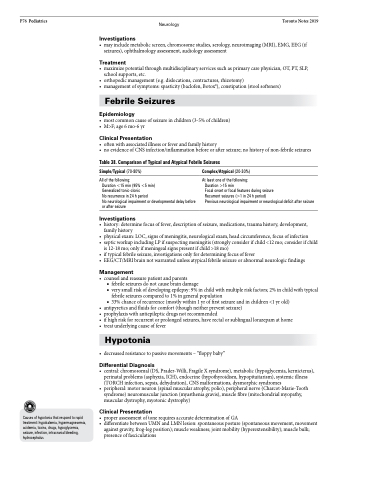Page 1110 - TNFlipTest
P. 1110
P76 Pediatrics
Neurology Toronto Notes 2019 • mayincludemetabolicscreen,chromosomestudies,serology,neuroimaging(MRI),EMG,EEG(if
seizures), ophthalmology assessment, audiology assessment
Treatment
• maximizepotentialthroughmultidisciplinaryservicessuchasprimarycarephysician,OT,PT,SLP, school supports, etc.
• orthopedicmanagement(e.g.dislocations,contractures,rhizotomy)
• managementofsymptoms:spasticity(baclofen,Botox®),constipation(stoolsofteners)
Febrile Seizures
Epidemiology
• mostcommoncauseofseizureinchildren(3-5%ofchildren) • M>F;age6mo-6yr
Clinical Presentation
• oftenwithassociatedillnessorfeverandfamilyhistory
• noevidenceofCNSinfection/inflammationbeforeorafterseizure;nohistoryofnon-febrileseizures
Table 38. Comparison of Typical and Atypical Febrile Seizures
Investigations
Simple/Typical (70-80%)
All of the following:
Duration <15 min (95% <5 min)
Generalized tonic-clonic
No recurrence in 24 h period
No neurological impairment or developmental delay before or after seizure
Investigations
Complex/Atypical (20-30%)
At least one of the following:
Duration >15 min
Focal onset or focal features during seizure
Recurrent seizures (>1 in 24 h period)
Previous neurological impairment or neurological deficit after seizure
Causes of hypotonia that respond to rapid treatment: hypokalemia, hypermagnesemia, acidemia, toxins, drugs, hypoglycemia, seizure, infection, intracranial bleeding, hydrocephalus
• history:determinefocusoffever,descriptionofseizure,medications,traumahistory,development, family history
• physicalexam:LOC,signsofmeningitis,neurologicalexam,headcircumference,focusofinfection
• septicworkupincludingLPifsuspectingmeningitis(stronglyconsiderifchild<12mo;considerifchild
is 12-18 mo; only if meningeal signs present if child >18 mo)
• iftypicalfebrileseizure,investigationsonlyfordeterminingfocusoffever
• EEG/CT/MRIbrainnotwarrantedunlessatypicalfebrileseizureorabnormalneurologicfindings
Management
• counselandreassurepatientandparents
■ febrile seizures do not cause brain damage
■ very small risk of developing epilepsy: 9% in child with multiple risk factors; 2% in child with typical
febrile seizures compared to 1% in general population
■ 33% chance of recurrence (mostly within 1 yr of first seizure and in children <1 yr old)
• antipyreticsandfluidsforcomfort(thoughneitherpreventseizure)
• prophylaxiswithantiepilepticdrugsnotrecommended
• ifhighriskforrecurrentorprolongedseizures,haverectalorsublinguallorazepamathome • treatunderlyingcauseoffever
Hypotonia
• decreasedresistancetopassivemovements–“floppybaby”
Differential Diagnosis
• central:chromosomal(DS,Prader-Willi,FragileXsyndrome),metabolic(hypoglycemia,kernicterus), perinatal problems (asphyxia, ICH), endocrine (hypothyroidism, hypopituitarism), systemic illness (TORCH infection, sepsis, dehydration), CNS malformations, dysmorphic syndromes
• peripheral:motorneuron(spinalmuscularatrophy,polio),peripheralnerve(Charcot-Marie-Tooth syndrome) neuromuscular junction (myasthenia gravis), muscle fibre (mitochondrial myopathy, muscular dystrophy, myotonic dystrophy)
Clinical Presentation
• properassessmentoftonerequiresaccuratedeterminationofGA
• differentiatebetweenUMNandLMNlesion:spontaneousposture(spontaneousmovement,movement
against gravity, frog-leg position); muscle weakness; joint mobility (hyperextensibility); muscle bulk; presence of fasciculations


